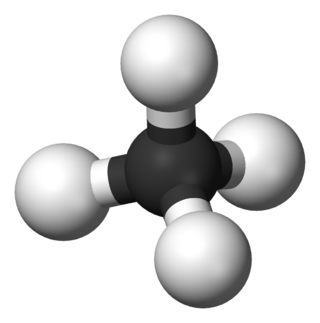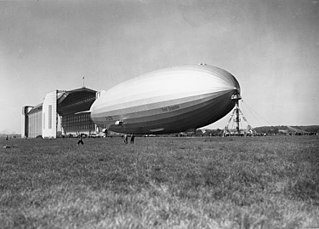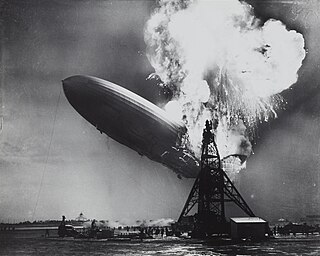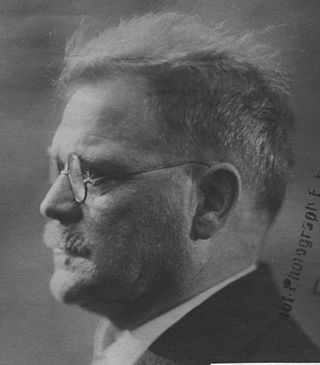
In organic chemistry, a hydrocarbon is an organic compound consisting entirely of hydrogen and carbon. Hydrocarbons are examples of group 14 hydrides. Hydrocarbons are generally colourless and hydrophobic; their odor is usually faint, and may be similar to that of gasoline or lighter fluid. They occur in a diverse range of molecular structures and phases: they can be gases, liquids, low melting solids or polymers.

A Zeppelin is a type of rigid airship named after the German inventor Ferdinand von Zeppelin who pioneered rigid airship development at the beginning of the 20th century. Zeppelin's notions were first formulated in 1874 and developed in detail in 1893. They were patented in Germany in 1895 and in the United States in 1899. After the outstanding success of the Zeppelin design, the word zeppelin came to be commonly used to refer to all rigid airships. Zeppelins were first flown commercially in 1910 by Deutsche Luftschiffahrts-AG (DELAG), the world's first airline in revenue service. By mid-1914, DELAG had carried over 10,000 fare-paying passengers on over 1,500 flights. During World War I, the German military made extensive use of Zeppelins as bombers and as scouts, resulting in over 500 deaths in bombing raids in Britain.

LZ 129 Hindenburg was a German commercial passenger-carrying rigid airship, the lead ship of the Hindenburg class, the longest class of flying machine and the largest airship by envelope volume. It was designed and built by the Zeppelin Company on the shores of Lake Constance in Friedrichshafen, Germany, and was operated by the German Zeppelin Airline Company. It was named after Field Marshal Paul von Hindenburg, who was President of Germany from 1925 until his death in 1934.
Coal gas is a flammable gaseous fuel made from coal and supplied to the user via a piped distribution system. It is produced when coal is heated strongly in the absence of air. Town gas is a more general term referring to manufactured gaseous fuels produced for sale to consumers and municipalities.

Synthetic oil is a lubricant consisting of chemical compounds that are artificially modified or synthesised. Synthetic lubricants can be manufactured using chemically modified petroleum components rather than whole crude oil, but can also be synthesized from other raw materials. The base material, however, is still overwhelmingly crude oil that is distilled and then modified physically and chemically. The actual synthesis process and composition of additives is generally a commercial trade secret and will vary among producers.

LZ 127 Graf Zeppelin was a German passenger-carrying hydrogen-filled rigid airship that flew from 1928 to 1937. It offered the first commercial transatlantic passenger flight service. The ship was named after the German airship pioneer Ferdinand von Zeppelin, a count in the German nobility. It was conceived and operated by Hugo Eckener, the chairman of Luftschiffbau Zeppelin.
The Fischer–Tropsch process (FT) is a collection of chemical reactions that converts a mixture of carbon monoxide and hydrogen, known as syngas, into liquid hydrocarbons. These reactions occur in the presence of metal catalysts, typically at temperatures of 150–300 °C (302–572 °F) and pressures of one to several tens of atmospheres. The Fischer–Tropsch process is an important reaction in both coal liquefaction and gas to liquids technology for producing liquid hydrocarbons.
Chemical changes occur when a substance combines with another to form a new substance, called chemical synthesis or, alternatively, chemical decomposition into two or more different substances. These processes are called chemical reactions and, in general, are not reversible except by further chemical reactions. Some reactions produce heat and are called exothermic reactions and others may require heat to enable the reaction to occur, which are called endothermic reactions. Understanding chemical changes is a major part of the science of chemistry.
Coal liquefaction is a process of converting coal into liquid hydrocarbons: liquid fuels and petrochemicals. This process is often known as "Coal to X" or "Carbon to X", where X can be many different hydrocarbon-based products. However, the most common process chain is "Coal to Liquid Fuels" (CTL).

The Graf Zeppelin was the last of the German rigid airships built by Zeppelin Luftschiffbau during the period between the World Wars, the second and final ship of the Hindenburg class, and the second zeppelin to carry the name "Graf Zeppelin" and thus often referred to as Graf Zeppelin II. Due to the United States refusal to export helium to Germany, the Graf Zeppelin II was filled with hydrogen and therefore never carried commercial passengers. It made 30 flights over 11 months in 1938–39, many being propaganda publicity flights; but staff of the Reich Air Ministry were aboard to conduct radio surveillance and measurements. The airship, along with its LZ 127 namesake were both scrapped in April 1940, and their duralumin framework salvaged to build aircraft for the Luftwaffe.

Industrial gases are the gaseous materials that are manufactured for use in industry. The principal gases provided are nitrogen, oxygen, carbon dioxide, argon, hydrogen, helium and acetylene, although many other gases and mixtures are also available in gas cylinders. The industry producing these gases is also known as industrial gas, which is seen as also encompassing the supply of equipment and technology to produce and use the gases. Their production is a part of the wider chemical Industry.
Water gas is a kind of fuel gas, a mixture of carbon monoxide and hydrogen. It is produced by "alternately hot blowing a fuel layer [coke] with air and gasifying it with steam". The caloric yield of this is about 10% of a modern syngas plant. Further making this technology unattractive, its precursor coke is expensive, whereas syngas uses cheaper precursor, mainly methane from natural gas.

The Hindenburg disaster was an airship accident that occurred on May 6, 1937, in Manchester Township, New Jersey. The LZ 129 Hindenburg was a German commercial passenger-carrying rigid airship, the lead ship of the Hindenburg class, the longest class of flying machine and the largest airship by envelope volume. It was designed and built by the Zeppelin Company and was operated by the German Zeppelin Airline Company. It was named after Field Marshal Paul von Hindenburg, who was President of Germany from 1925 until his death in 1934. It caught fire and was destroyed during its attempt to dock with its mooring mast at Naval Air Station Lakehurst. The accident caused 35 fatalities from the 97 people on board, and an additional fatality on the ground.

The two Hindenburg-class airships were hydrogen-filled, passenger-carrying rigid airships built in Germany in the 1930s and named in honor of Paul von Hindenburg. They were the last such aircraft to be constructed, and in terms of their length, height, and volume, the largest aircraft ever built. During the 1930s, airships like the Hindenburg class were widely considered the future of air travel, and the lead ship of the class, LZ 129 Hindenburg, established a regular transatlantic service. The airship's destruction in a highly publicized accident was the end of these expectations. The second ship, LZ 130 Graf Zeppelin, was never operated on a regular passenger service, and was scrapped in 1940 along with its namesake predecessor, the LZ 127 Graf Zeppelin, by order of Hermann Göring.
August Riedinger was a German businessman who operated gas companies in Germany and Europe and also participated in balloon and airship manufacturing.

This is a timeline of the history of hydrogen technology.
The static buoyancy of airships in flight is not constant. It is therefore necessary to control the altitude of an airship by controlling its buoyancy: buoyancy compensation.

A fuel is any material that can be made to react with other substances so that it releases energy as thermal energy or to be used for work. The concept was originally applied solely to those materials capable of releasing chemical energy but has since also been applied to other sources of heat energy, such as nuclear energy.

Hermann Blau was a German engineer and chemist, and inventor of Blau gas.

Deutsche Zeppelin-Reederei, abbreviated DZR, is a German limited-liability company that operates commercial passenger zeppelin flights. The current incarnation of the DZR was founded in 2001 and is based in Friedrichshafen. It is a subsidiary of Zeppelin Luftschifftechnik and operates Zeppelin NT "Next Generation" airships. By 2009 the DZR had transported over 55,000 passengers. As of 2012 the DZR flies a schedule of 12 tour routes between March and November in Southern Germany. The company also operates flights to other selected cities as well as charter flights.













